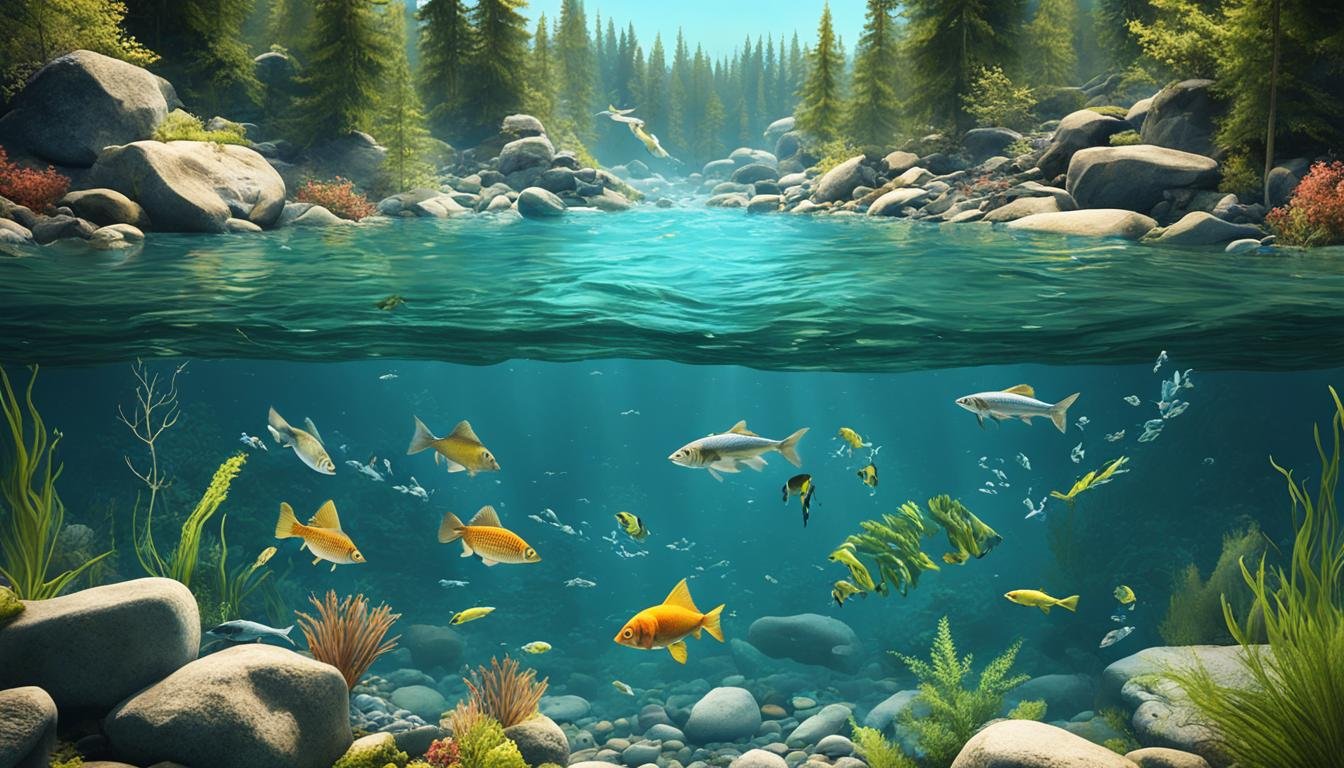Table of Contents
Did you know that understanding the signs of fish activity can significantly improve your fishing success?
It’s true! Fish behavior is influenced by various factors, and by learning how to read the water, you can decipher the presence and behavior of fish.
In this article, we will explore different signs of fish activity and how you can interpret them to increase your chances of a rewarding catch.
Key Takeaways:
- By recognizing signs of fish activity, you can adapt your fishing techniques for better results.
- Reading the water allows you to identify the presence and behavior of fish.
- Fish behavior is influenced by various factors, including environmental conditions and natural instincts.
- Understanding the signs of fish activity can help you locate productive fishing spots and adjust your fishing strategies accordingly.
- By mastering the art of reading the water, you can increase your fishing success and have a more rewarding fishing experience.
Interpreting Barometric Pressure for Fish Movement
Barometric pressure, also known as atmospheric pressure, has a profound impact on fish behavior and movement. Understanding how changes in barometric pressure affect water bodies and fish activity is crucial for successful fishing. By interpreting this relationship and implementing effective fishing strategies during pressure shifts, you can significantly improve your chances of a fruitful catch.
The Impact of Atmospheric Conditions on Water Bodies
Atmospheric conditions, including barometric pressure, temperature, humidity, and wind, directly influence the behavior of fish and the overall ecosystem of water bodies. Changes in barometric pressure can lead to variations in water density, oxygen levels, and the availability of food sources, all of which affect fish movement and feeding patterns. By paying attention to these atmospheric conditions, anglers can gain valuable insights into the areas and techniques that are likely to yield the best results.
How Barometric Pressure Influences Fish Behavior
Barometric pressure directly affects fish behavior by impacting their swim bladder, which is responsible for buoyancy control. When the barometric pressure decreases, fish may experience discomfort due to the expansion of gases in their swim bladder. Consequently, they tend to move to deeper water or seek cover to alleviate this discomfort. Conversely, when the barometric pressure increases, fish may become more active and move to shallower areas in search of food.
Effective Fishing Strategies During Pressure Shifts
During pressure shifts, adapting your fishing strategies can significantly improve your chances of success. Here are some effective techniques to consider:
- Pre-frontal fishing: Prioritize fishing before a front arrives and the barometric pressure starts to drop. This is often a time of increased fish activity, and they may be more willing to strike.
- Post-frontal fishing: After a front passes, when the barometric pressure stabilizes or begins to rise, fish can become less active. In such conditions, focus on slower presentations and fishing deeper waters where fish may seek refuge.
- Experiment with bait: Changing your bait or lure presentation can be effective in enticing fish to bite during pressure shifts. Consider using bait that imitates the natural food sources that fish are likely to target in response to changing conditions.
- Observe fish behavior: Pay close attention to how fish are behaving during pressure shifts. Look for any changes in their feeding patterns, location, or activity level. This observation can provide valuable clues about the most productive fishing techniques and areas.
By staying attuned to the changes in barometric pressure and implementing appropriate fishing strategies, you can increase your chances of a successful fishing outing, even during pressure shifts.
Identifying Fish Activity Through Tidal Movements
Tidal movements can provide valuable insights into fish activity, helping you become a more successful angler. By understanding how fish behave during different tidal phases, you can pinpoint productive fishing locations and tailor your fishing techniques accordingly.
During incoming tides, the rising water floods nearshore areas, driving baitfish and other prey closer to the shore. This presents an excellent opportunity to target predatory fish that follow the baitfish. Look for active feeding and surface disturbances in these areas.
Conversely, during outgoing tides, the receding water carries baitfish and prey away from the shore. Predator fish often lurk in deeper water, waiting for the chance to ambush their prey. Focus your fishing efforts around drop-offs, structure, or channels where predator fish may be waiting.
Understanding the relationship between fish activity and tidal movements is crucial for maximizing your fishing success. By adapting your fishing strategy to different tidal phases, you can increase your chances of landing that trophy fish. Stay tuned for the next section, where we’ll explore the connection between fish feeding times and tidal patterns.
The Connection Between Fish Feeding Times and Tidal Patterns
Understanding the relationship between fish feeding times and tidal patterns is key to maximizing your fishing success. Fish feeding times are often influenced by the changes in tidal patterns, making it crucial to strategically plan your angling around these fluctuations. Additionally, utilizing tide tables can provide valuable information about the best times to fish in specific locations, ensuring fishing efficiency.
Strategic Angling Around High and Low Tides
During high and low tides, fish are more active and feeding opportunities increase. By strategically angling during these tidal phases, you can increase your chances of catching more fish. During high tides, fish move closer to the shorelines and take advantage of the increased water depth to hunt for prey. Casting your bait closer to the shoreline can yield excellent results during high tides.
Similarly, during low tides, fish concentrate in deeper areas, such as channels and drop-offs. Positioning yourself in these areas and targeting the deeper pockets can lead to successful catches. Understanding the behavior of fish during high and low tides and adjusting your angling techniques accordingly can significantly improve your fishing outcomes.
Utilizing Tide Tables for Maximum Fishing Efficiency
Tide tables, which provide information about the timing and height of tides, are invaluable tools for anglers. By consulting tide tables, you can determine the best times to fish in specific locations. High and low tides occur at different times each day, and fishing during the optimal tidal phases can greatly enhance your fishing efficiency.
When utilizing tide tables, pay attention to the tidal coefficients, which indicate the amplitude and range of tides. Higher coefficients usually correspond to more pronounced tidal movements, increasing the likelihood of active fish feeding times. By aligning your fishing trips with favorable tidal coefficients, you can maximize your chances of success.

Deciphering the Language of Currents and Fish Behavior
Currents play a vital role in understanding fish behavior and feeding times. By decoding the signals conveyed by current shifts, you can determine the optimal moments to fish. Additionally, mastering the art of reading river flow will help you identify productive fishing spots. Let’s explore the relationship between currents and fish behavior, discover how current shifts signal feeding times, and learn valuable tips for interpreting river flow.
How Current Shifts Signal Feeding Times
Current shifts provide valuable clues about fish feeding behavior. When the current speeds up or changes direction, it often indicates an increase in fish activity and feeding times. For example, during tidal changes or periods of rising water levels, the movement of water prompts fish to become more active and search for food. By paying close attention to current shifts, you can optimize your fishing time for maximum success.
Reading River Flow for Productive Fishing Spots
Understanding how to read river flow can guide you to fruitful fishing spots. Different areas of a river may have variations in current speed, depth, and structure, which can attract fish. Look for areas with slower currents and eddies, as these tend to be favored by fish seeking refuge or areas with abundant food sources. Additionally, pay attention to changes in water color, temperature, and the presence of floating debris, as these can also indicate the potential presence of fish. By honing your skills in reading river flow, you can narrow down your search for the best fishing spots.
| Signs of Productive Fishing Spots | Interpretation and Action |
|---|---|
| Mild current with slow or no visible surface movement | Indicates potential areas where fish may be resting or seeking shelter. Use light tackle and finesse techniques for optimal results. |
| Distinct current seams or eddies | These areas can concentrate prey, making them attractive to fish. Cast lures or bait along the edges of the current seams to target feeding fish. |
| Submerged structures or vegetation | Fish often utilize these elements as cover, so focus your efforts around submerged structures or areas with dense vegetation. Employ techniques such as flipping or pitching to entice strikes. |
Recognizing Signs of Fish Activity
Being able to recognize signs of fish activity is essential for successful fishing. By understanding and interpreting these signs, you can increase your chances of a rewarding catch. Here are some key indicators to look out for:
- Surface disturbances: Pay attention to ripple patterns or small waves on the water’s surface. This can indicate fish movement or feeding activity.
- Baitfish behavior: Keep an eye on schools of baitfish. If they are clustering or moving erratically, it could mean predators are nearby.
- Bird activity: Seabirds, such as seagulls and pelicans, can give away the presence of feeding fish. Watch for birds diving or circling above the water.
- Jumping fish: Some species of fish, like salmon or trout, are known for leaping out of the water. If you spot fish jumping, it’s a clear sign of activity beneath the surface.
- Nibbling or tugging on the line: When you feel small nips or twitches on your fishing line, it could mean fish are showing interest in your bait.
- Flashing or vibrant colors: If you see flashes of silver or vibrant colors in the water, it may indicate fish swimming or chasing prey.
Keep in mind that fish behavior can vary depending on the species and the fishing location. Paying close attention to these signs will help you determine the best fishing spots and adjust your techniques accordingly. Trust your instincts and experience to make the most of these fish activity indicators.
In the image below, you can see an example of birds diving for fish, a clear indication of fish activity:

Observing Water Clarity and its Effects on Fish Habits
Water clarity plays a crucial role in understanding fish behavior and habits. The clarity of the water can greatly affect fishing success, and adjusting your techniques based on the water clarity can make a significant difference in your catch. Additionally, there are visual cues in water clarity that can indicate the presence of fish.
Adjusting Techniques for Murky vs. Clear Water
In murky water, where visibility is limited, it’s important to adapt your fishing techniques to increase your chances of success. Here are some tips:
- Use lures or baits with bright colors or high contrast to stand out in the murky water.
- Focus on using scent-based attractants to attract fish in low visibility conditions.
- Consider using noise-making lures or baits to grab the attention of fish in murky water.
- Opt for slow, methodical retrieves to allow fish to locate and strike your bait.
On the other hand, in clear water, where visibility is high, fish might be more cautious and easily spooked. Adjust your techniques accordingly:
- Use natural-colored lures or baits that blend in with the surroundings.
- Employ finesse techniques like drop shotting or using lighter line and smaller baits.
- Focus on making longer casts to avoid alerting fish to your presence.
- Utilize stealthy movements and approach fishing spots with caution.
Visual Cues in Water Clarity that Reveal Fish Presence
Visual cues in water clarity can provide valuable information about the presence of fish. Look out for:
- Splashes or disturbances on the water surface, indicating fish feeding or activity.
- Visible schools of baitfish that attract larger predatory fish.
- Observe for bird activity such as diving birds, which can indicate the presence of fish beneath the surface.
- Look for shadows or patterns in the water that could indicate fish movement.
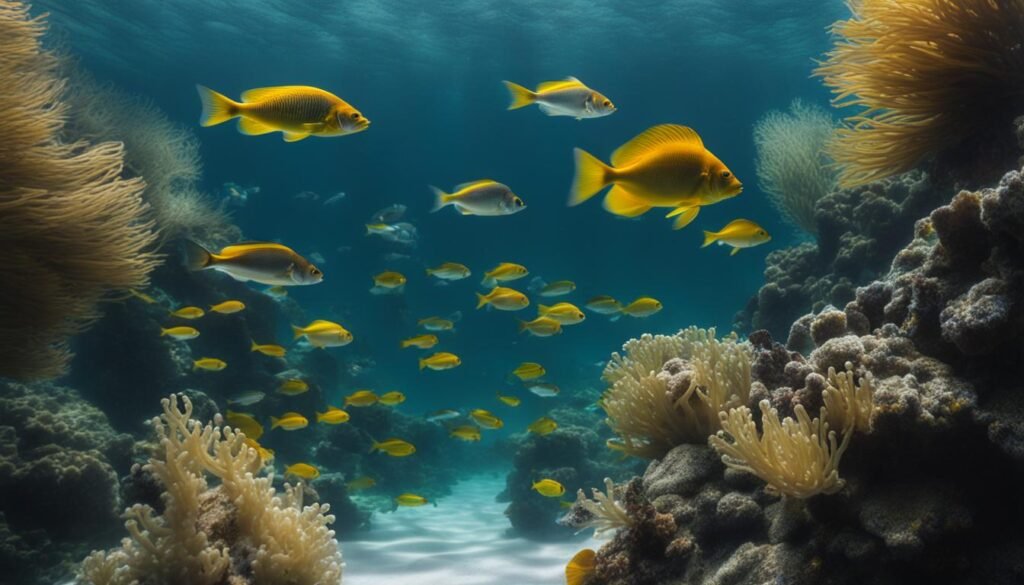
In summary, understanding the effects of water clarity on fish habits is essential for successful fishing. Adjusting your techniques for murky or clear water and recognizing visual cues in water clarity can significantly improve your chances of a rewarding catch.
Temperature Variations and Their Impact on Aquatic Life
Temperature variations play a critical role in the behavior and survival of aquatic life, including fish. Understanding the optimum water temperatures for different species is key to maximizing fishing success. Additionally, fishing around thermoclines, which are areas where water temperatures rapidly change, offers great potential for productive catches.
Optimum Water Temperatures for Targeted Species
Each species of fish has specific temperature preferences that dictate their activity and feeding patterns. Knowing the optimum water temperatures for the fish you are targeting allows you to plan your fishing trips more effectively.
For example:
- Bass tend to be more active in water temperatures ranging from 65 to 85 degrees Fahrenheit.
- Trout thrive in cooler temperatures, typically between 50 and 60 degrees Fahrenheit.
- Walleye are most active in water temperatures around 65 to 70 degrees Fahrenheit.
By understanding the preferred temperature range of your target species, you can choose the right time and location to increase your chances of a successful catch.
Fishing Around Thermoclines for Success
Thermoclines are areas where there is a rapid change in water temperature within a vertical column of water. These zones can be highly productive for fishing, as they often concentrate baitfish and attract predatory species.
When fishing around thermoclines, consider the following techniques:
- Use a fishfinder or depth sounder to locate thermoclines. Look for abrupt temperature changes on the screen.
- Target areas where the thermocline intersects with underwater structure, such as drop-offs, weed edges, or submerged rocks.
- Present your bait or lure at the depth where the thermocline is located. Many fish species, including bass and walleye, may suspend just above or below the thermocline to take advantage of the temperature gradient.
- Experiment with different baits and lures to entice fish in these thermocline zones. Fish may exhibit different feeding behaviors in response to the temperature variations.
Fishing around thermoclines requires careful observation and experimentation. By capitalizing on these temperature variations, you can increase your chances of hooking into some trophy fish.
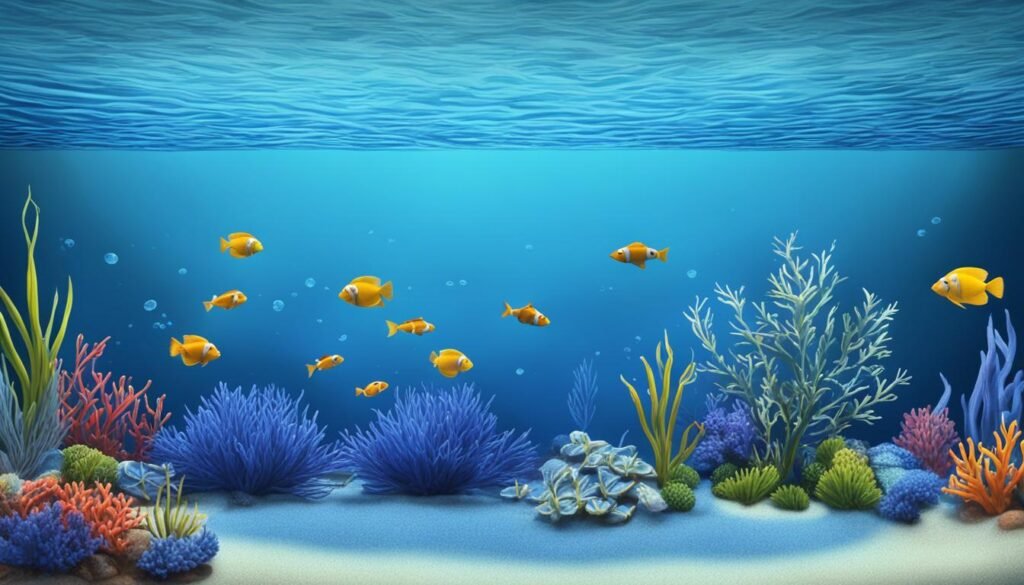
| Fish Species | Optimum Water Temperature (°F) |
|---|---|
| Bass | 65-85 |
| Trout | 50-60 |
| Walleye | 65-70 |
Seasonal Fish Movements and Habitat Selection
Fish exhibit seasonal movements and select specific habitats during different times of the year. Understanding fish migration patterns and knowing where to fish during different seasons can greatly enhance fishing success. By aligning your fishing strategies with the natural rhythms of fish behavior, you can significantly increase your chances of a rewarding catch.
Understanding Migration Patterns for Effective Fishing
When it comes to seasonal fish movements, understanding migration patterns is key. Different fish species migrate for various reasons, including spawning, feeding, or seeking favorable environmental conditions. By studying the migratory behaviors of your target species, you can pinpoint the best locations and times to fish.
Whether it’s following the movement of salmon upstream or intercepting the migration route of striped bass along the coast, tapping into these patterns can lead to more productive fishing trips.
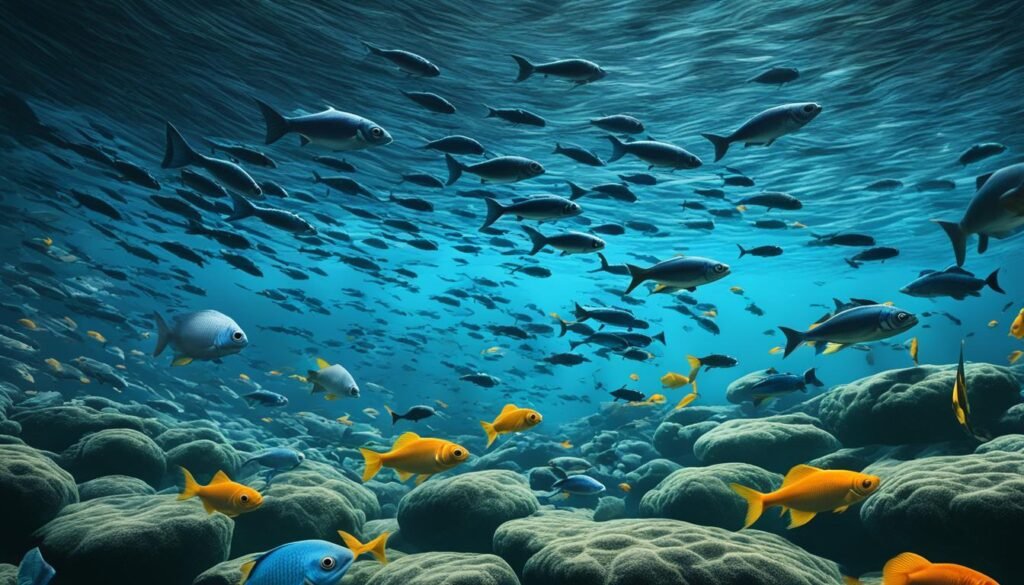
Where to Fish During Different Seasons
Habitat selection plays a crucial role in fishing success. In each season, fish seek out specific environments that provide them with the necessary conditions for survival and reproduction. For example, during the spring, many fish species move closer to shorelines or river mouths for spawning.
In the summer, fish may retreat to deeper, cooler waters to escape the heat. Fall brings migrations towards feeding grounds, while winter sees fish gathering in deeper, warmer pockets. By understanding the seasonal preferences of your target species, you can effectively narrow down your fishing spots and increase your chances of landing a prized catch.
| Season | Habitat Selection | Fishing Strategies |
|---|---|---|
| Spring | Shorelines, river mouths for spawning | Focus on these areas using lures or bait that mimic spawning behavior. |
| Summer | Deeper, cooler waters | Target thermoclines or use deepwater fishing techniques to reach fish at lower depths. |
| Fall | Feeding grounds | Identify migration routes and key feeding areas to intercept fish on their journey. |
| Winter | Deeper, warmer pockets | Focus on areas with thermal gradients or use ice fishing techniques to access fish under the ice. |
With this knowledge, you can plan your fishing trips strategically, targeting the right habitats at the right time, and increasing your chances of success.
Weather Phenomena and Fishing Opportunities
Weather phenomena play a crucial role in fishing opportunities. Understanding how different weather patterns influence fish behavior is key to determining the best times and techniques for successful fishing.
Here, we will explore various weather phenomena and their effects on fish activity, provide fishing strategies for different weather conditions, and offer insights into how you can maximize your fishing opportunities.
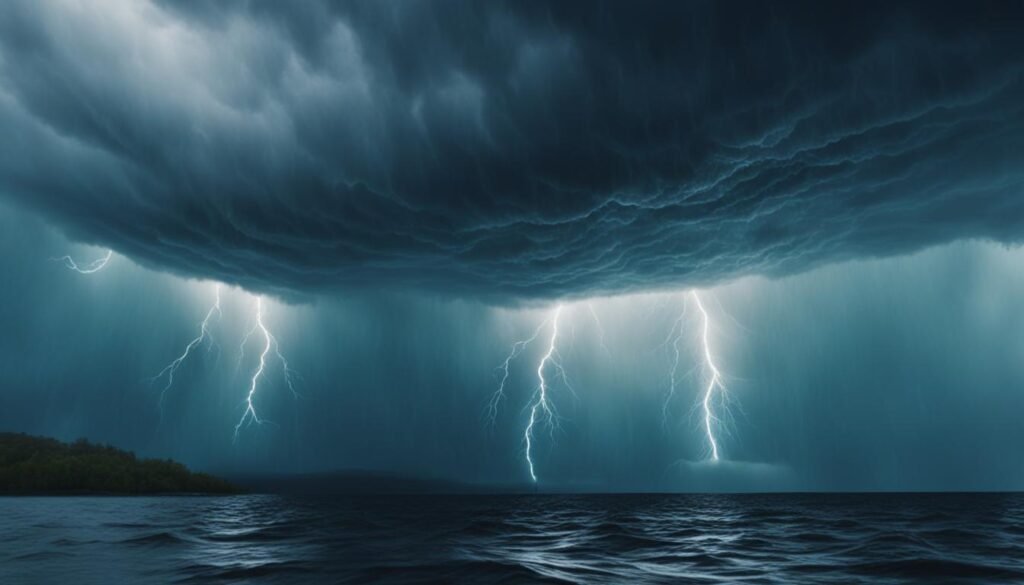
Effects of Weather Phenomena on Fish Activity
Weather patterns such as rain, wind, temperature changes, and atmospheric pressure fluctuations have a significant impact on fish behavior. For example, rainy weather can stimulate feeding activity as raindrops create surface disturbances and dislodge insects, attracting fish to the surface.
Wind can also push baitfish closer to the shore, creating feeding opportunities for predator fish. Understanding these effects will help you identify optimal fishing spots and techniques for different weather conditions.
Fishing Strategies for Different Weather Conditions
Adapting your fishing strategies to different weather conditions is crucial for maximizing your chances of a successful catch. Here are some strategies to consider:
- On sunny days, fish tend to seek shelter in deeper water. Use deeper diving lures or fish in shaded areas like under docks or near vegetation.
- During cloudy or overcast days, fish are more likely to be active and near the surface. Topwater lures or shallow running baits can be effective.
- When it’s raining, focus on areas where rainwater runoff enters the water, as this can create concentrated feeding zones for fish.
- On windy days, target windblown shorelines or areas where wave action creates underwater turbulence, concentrating baitfish and attracting predator fish.
- If there is a significant drop in atmospheric pressure, fishing near structure or in deeper water can be productive, as fish may move deeper to stabilize their swim bladder.
Maximizing Fishing Opportunities
To maximize your fishing opportunities, it’s essential to stay updated on weather forecasts and patterns. Pay attention to weather changes and plan your fishing trips accordingly. Fishing early in the morning or late in the evening when weather conditions are generally more stable can increase your chances of success.
Additionally, consider using fishing apps or websites that provide real-time weather updates and fishing predictions for your specific location. By being well-prepared and adapting your fishing strategies to weather phenomena, you can significantly enhance your fishing opportunities.
Natural and Human-Induced Environmental Factors
Natural and human-induced environmental factors play a significant role in shaping fish behavior and fishing opportunities. Understanding how these factors impact fish can help anglers adapt their techniques and increase their chances of success. In this section, we will explore the various environmental factors that influence fish behavior and discuss the effects of recreational activities on fish.
Assessing the Effects of Recreational Activities on Fish
Recreational activities, such as boating, swimming, and fishing itself, can have both direct and indirect effects on fish. These activities can lead to disturbances in fish habitat, changes in water quality, and alterations in food availability. It’s important for anglers to be aware of their impact on the fish population and take steps to minimize any negative effects.
By practicing responsible fishing techniques, such as catch and release, respecting fishing regulations, and promoting conservation efforts, anglers can help maintain healthy fish populations and ensure sustainable fishing for future generations.
Adapting to Natural Environmental Shifts for Better Catches
In addition to recreational activities, natural environmental shifts, such as changes in water temperature, water clarity, and seasonal variations, can significantly affect fish behavior. To increase your chances of a successful catch, it’s important to adapt your fishing techniques to these shifts.
For example, during colder water temperatures, fish tend to become less active and may seek deeper waters. Adjusting your fishing techniques, such as using slower bait presentations or targeting areas with more favorable water temperatures, can help you attract and catch fish even in challenging conditions.
Similarly, changes in water clarity can impact the visibility of your bait. In murky water, consider using lures or baits with more vibration or scent to attract fish, while in clear water, opt for more natural-looking baits that mimic the available prey.
By staying attuned to these natural environmental shifts and adapting your fishing techniques accordingly, you can increase your chances of landing that prized catch, no matter the conditions.
Using Technological Tools for Predicting Fish Activity
Technological tools have revolutionized the way anglers approach fishing, providing valuable resources for predicting fish activity and increasing angling success. By leveraging mobile apps for real-time fishing data and utilizing fishing barometers, anglers can obtain valuable information and insights that can significantly enhance their fishing experience.
Leveraging Mobile Apps for Real-time Fishing Data
Mobile apps have become indispensable tools for modern anglers, offering real-time data on weather conditions, water temperatures, and fish activity. These apps provide anglers with instant access to key information, making it easier to plan fishing trips and adjust strategies based on the latest updates.
With the help of these apps, you can stay informed about the latest fishing reports, track fish movements, and receive alerts when conditions become ideal for your target species. Some popular mobile apps for fishing include Fishbrain, Fishidy, and Anglr, which provide a wealth of information and features designed to maximize your angling success.
The Role of Fishing Barometers in Angling Success
Fishing barometers are specialized devices that measure atmospheric pressure, helping anglers predict fish behavior and adjust their fishing techniques accordingly. Changes in barometric pressure can significantly impact fish activity, influencing their feeding and movement patterns.
By monitoring barometric pressure, anglers can identify periods of low or high pressure that are favorable for fishing. A falling barometer often indicates an approaching storm or a decrease in pressure, which can trigger increased fish activity. On the other hand, a rising barometer suggests stable weather conditions and may lead to decreased fish activity.
Investing in a quality fishing barometer and learning how to interpret the pressure readings can provide you with a valuable edge on the water. Some popular fishing barometers include the Suunto Core, Garmin Quatix, and Casio Pro Trek, which offer accurate pressure readings and other useful features to enhance your angling success.
By utilizing technological tools like mobile apps and fishing barometers, anglers can stay one step ahead of the game, increasing their chances of predicting fish activity and maximizing their angling success.
Conclusion
To achieve fishing success, it is essential to understand the signs of fish activity and effectively read the water. By recognizing and interpreting the various indicators of fish behavior, you can adapt your fishing techniques and increase your chances of a rewarding catch.
This article has explored the different factors that influence fish activity and provided valuable insights into optimizing your fishing strategies. By understanding the impact of barometric pressure, tidal movements, currents, water clarity, temperature variations, seasonal fish movements, weather phenomena, and environmental factors, you can make informed decisions about when and where to fish.
With this knowledge, you can approach your fishing adventures with confidence and maximize your fishing success. Whether you’re a seasoned angler or just starting out, paying attention to the behavior of fish, observing their surroundings, and adjusting your techniques accordingly can significantly improve your fishing outcomes.
Remember to stay informed, adapt to changing conditions, and keep exploring new techniques to enhance your angling skills.
FAQ About Signs of Fish Activity
What are some signs of fish activity?
Signs of fish activity include surface disturbances, baitfish behavior, bird activity, and more.
How can I read the water to identify fish behavior?
Reading the water involves understanding various indicators such as barometric pressure, tidal movements, currents, water clarity, temperature variations, and environmental factors.
How does barometric pressure influence fish behavior?
Changes in barometric pressure can affect water bodies and impact fish activity. Understanding this relationship can help anglers strategize for better catches.
What are some effective fishing strategies during pressure shifts?
Fishing during pressure shifts requires adapting techniques and adjusting to the changing conditions. Seeking out areas with cover and using different bait presentations can be beneficial.
How can tidal movements help identify fish activity?
Fish behavior during different tidal phases can provide valuable clues about their locations and feeding patterns. Understanding this relationship can help anglers target productive fishing spots.
How can I utilize tide tables for fishing efficiency?
Tide tables provide information about the best times for fishing in specific locations. By planning your fishing trips around high and low tides, you can maximize your chances of success.
How do current shifts signal feeding times?
Changes in current patterns can indicate when fish are actively feeding. Observing the direction and intensity of the current can help anglers determine the best times to fish.
How can I read river flow to identify productive fishing spots?
Observing the flow of the river can reveal areas where fish are likely to congregate. Look for eddies, riffles, and areas with cover that provide favorable conditions for fish.
What are some signs of fish presence in the water?
Visual cues such as swirls, splashes, or disturbances on the water’s surface can indicate fish activity. Additionally, observing the behavior of baitfish and the presence of birds can be helpful in identifying fish.
How does water clarity affect fish behavior?
Fish behavior and habits can be influenced by water clarity. Adjusting fishing techniques based on whether the water is murky or clear can improve fishing success.
What are some visual cues that reveal fish presence in the water?
Visual cues such as the presence of fish shadows, fins breaking the water’s surface, or the movement of fish in clear water can indicate the presence of fish.
How do temperature variations impact fish behavior?
Fish have specific temperature preferences, and understanding the optimum water temperatures for targeted species can help anglers determine the best fishing conditions. Fishing around thermoclines, where water temperatures rapidly change, can also lead to successful catches.
How can I identify fish migration patterns and select the right fishing locations?
Different fish species exhibit seasonal movements and select specific habitats during different times of the year. Understanding their migration patterns can help anglers identify the best fishing locations during each season.
What is the impact of weather phenomena on fish activity?
Different weather patterns can influence fish behavior and feeding. Understanding how various weather conditions affect fish can help anglers determine the best times and techniques for fishing.
How do natural and human-induced environmental factors influence fish behavior?
Environmental factors such as water pollution or changes in habitat can significantly impact fish behavior. Assessing their effects and adapting fishing techniques accordingly can lead to better catches.
How can technological tools help predict fish activity?
Mobile apps that provide real-time fishing data and fishing barometers can be valuable resources for anglers. These tools offer insights into fish activity and help anglers plan their fishing trips more effectively.
Source Links
- https://www.in-fisherman.com/editorial/understanding-barometric-pressure/154358
- https://www.takemefishing.org/how-to-fish/when-to-fish/tides-for-fishing/
- https://www.flyfisherman.com/editorial/Temps-for-Trout-How-to-Catch-Fish-that-Behave-Hot-n-Cold/379972
